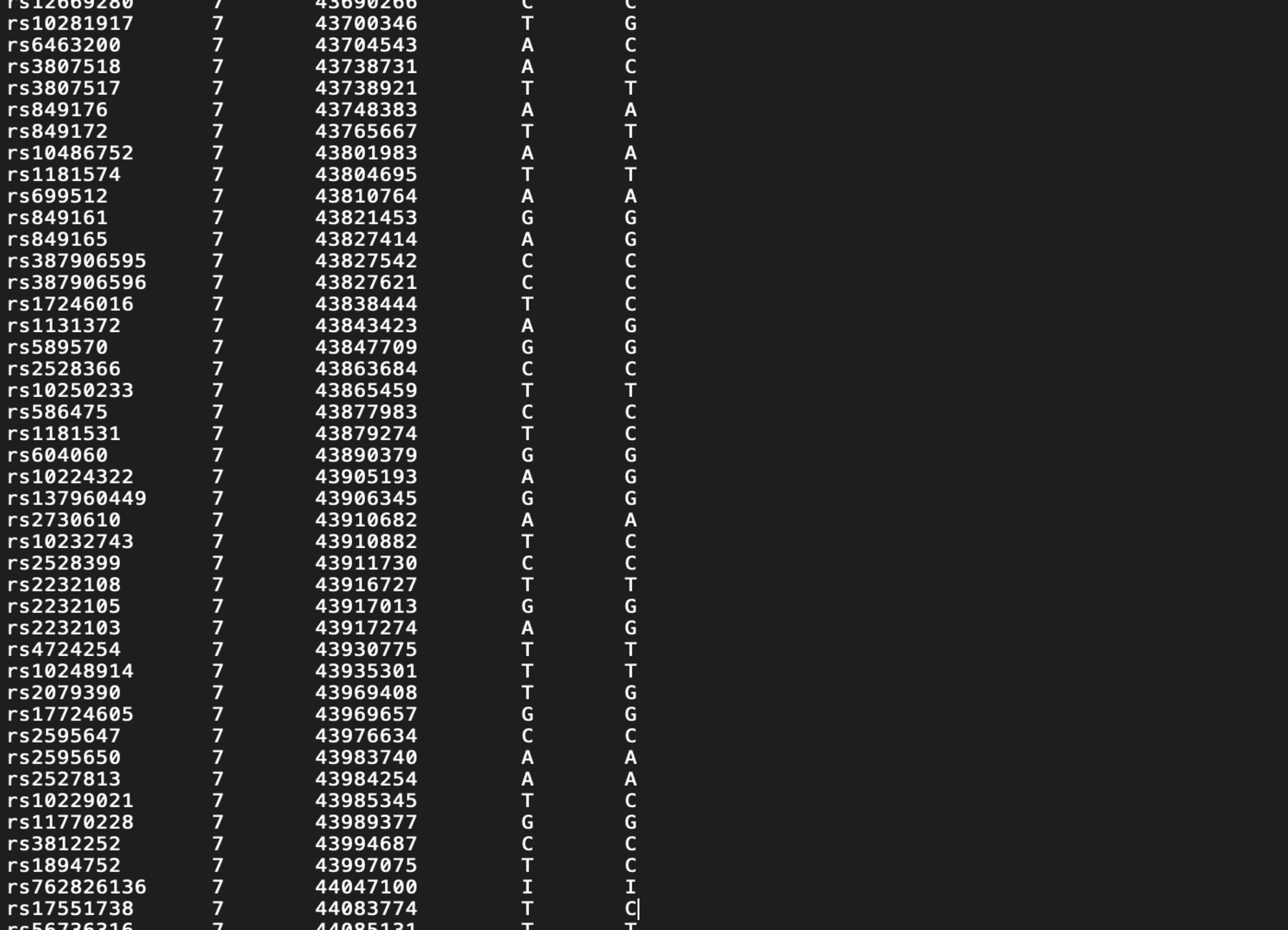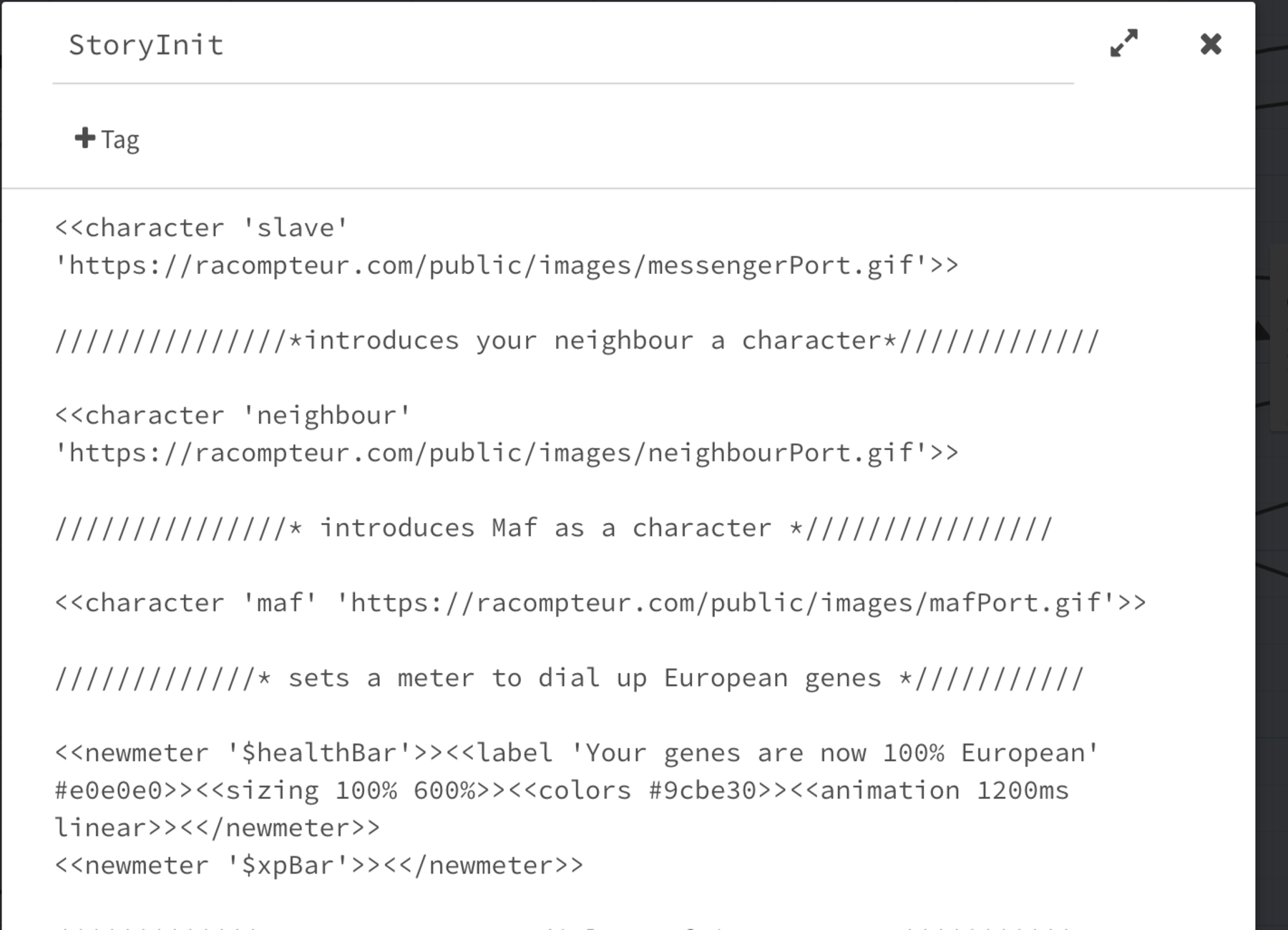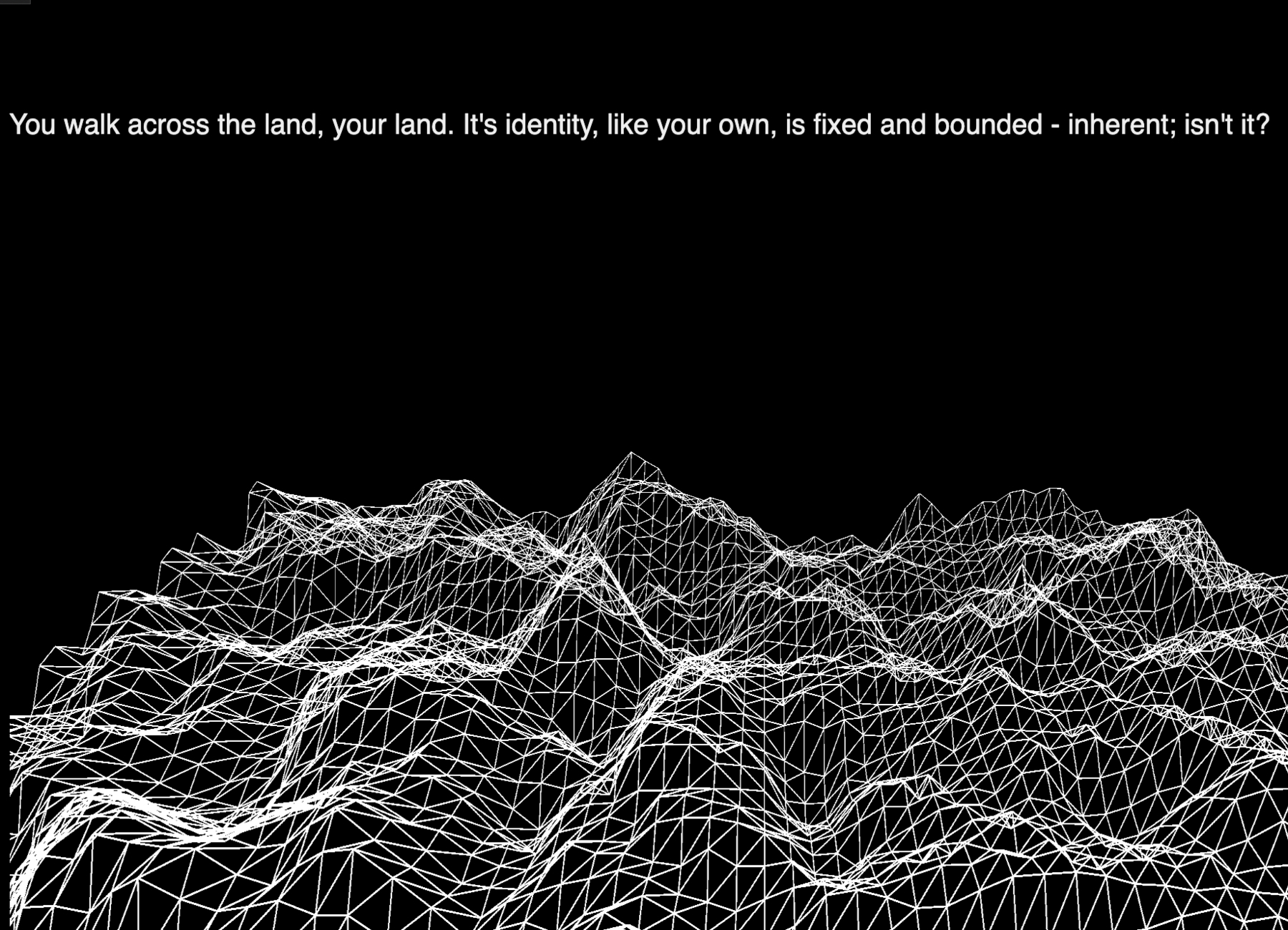Choose Your anceStory™
Choose Your anceStory™ is a web-based work of interactive-fiction, intended as a meditation on the performative nature of ancestral identity.
produced by: James Quinn
introduction™
Inspired by Karen Barad’s agential-realist framework, a cult 1970s TV-play, and the artist’s recent encounter with commercial DNA testing, Choose Your anceStory™ is a computational narrative thought-experiment.
The piece invites its audience to consider how an observer’s apparatus of observation configures their perception of ancestral identity.
In its fictional world, satirical tech company Choose Your anceStory™ offers you the chance to partake in a novel DNA test, one that lets you dial up genes from whichever part of the world you identify with most. Afterwards, you get to experience your own interactive ancestral story - your anceStory™.
conceptAndBackgroundResearch™
Three events brought Choose Your anceStory™ into being. The first occurred when I dropped my ancestry DNA sample in the local post box. The second when I read Nature’s Queer Performativity by Karen Barad. And the third when I watched 1970s TV-play, Penda’s Fen.
Penda’s Fen by David Rudkin follows adolescent Stephen on his spiritual coming-of age, as a series of supernatural encounters drives his progression from precocious certainty, regarding his nationality, gender, sexuality, and religion, to a deeper and more nuanced understanding of the active and ever-shifting nature of those identity categories, which once seemed so fixed and inherent to him.
The story struck me as relevant this summer, as numerous public voices asserted the inherent criminality of people of African ancestry, while others professed the inherent bigotry of people of European ancestry. Was ancestral identity really an inherent property, I wondered?
Meanwhile I found myself checking my emails four times a day for my Ancestry DNA results. Why did I care? After considerable soul-searching, I discovered that I hoped my ancestry data would enrich my sense of who I am; that this company could sell me an ancestral identity. I felt shocked and slightly embarrassed that ancestral identity mattered to me. An MIT study, reporting that 26 million people have taken the test to date, suggested I wasn’t alone.
Then I opened Nature’s Queer Performativity. Barad draws upon quantum physics to outline her theory of agential-realism which, in contrast to dualistic newtonian physics, that views the world as a space full of distinct objects with determinate properties and boundaries, asks instead that we respect the countless ways in which entities are entangled with one another.
Identity, for example, is, according to Barad, neither fixed, permanent or inherent. Rather it is performative. Always in a state of perpetual becoming, with its observer, and the tools they use to observe it, playing a defining role in its emergence and perception.
She exemplifies her point with 1920s physicist Neils Bohr’s slit-screen experiment which passes matter through a slitted screen onto another screen. When measured with one set of apparatus, the matter appears on the other side as a wave. But when measured with a modified set of apparatus, the same matter appears as a particle. Barad claims this empirically proves identity is performative.
This resonated with me but also contradicted my hopes for my DNA results. What can my ancestral identity mean, if identity itself is impermanent and indeterminate?
After surveying twelve people who had recently taken a DNA test, I learned that others grappled with similar questions. So I decided to create an interactive narrative space to reflect upon ancestral identity’s performativity, and Choose Your anceStory™ is the result.
I knew this subject had the potential to offend and that was the last thing I wanted so I conducted play-testing with people of diverse ancestries, and I’m pleased to report that no-one identified any offensive content.
technical™
Audience interaction was key. To consider the role an observer, along with their observation tools, plays in how ancestral identity emerges, the audience had to assert significant agency within the story, to make choices in it that affected their experience, to perform what Barad might describe as “agential cuts” by choosing their ancestral identity and narrative journey.
The piece therefore is built using an open-source, interactive-fiction tool called Twine. Inspired by the plot of Penda’s Fen, Twine allowed me to map branching narrative pathways made up of passages for the audience to navigate by choosing and clicking links.
Within the JavaScript file of my Twine program, a section of p5.js code, that I converted to instance mode, is wrapped in a function that is called in various passages. When that happens, images I created with 3D-printed artist-dummy heads and household items are called from a web-server before the p5.js code maps abstract, interactive graphics onto them. Not only do the graphics adhere to theme by their perpetually shifting appearance, but their abstract nature is also designed to encourage the audience to project the aesthetics of whichever geographic region they chose onto the characters and locations, thereby participating in their performative becoming.
On the story’s second play-through, when the audience is invited to dial up genes from somewhere else, story passages feature an HTML macro that checks whether they have played before. If they have, the macro triggers and loops sound-clips of emotive sentences from my survey responses. A performative soundscape soon emerges, along with the revelation that the audience would have faced identical narrative options, whichever ancestral identity they chose. Now the audience are observing the same narrative matter but with modified observation tools, in what I hope is an artistic echo of Neils Bohr’s slit-screen experiment.
Various other HTML macros allowed me to deploy graphic animations like dialogue boxes, the DNA test, and the data reading section that uses my real-life, raw genetic data. I also implemented CCS styling to design the look and feel of the piece.
futureDevelopment™
Aside from final tweaks and polishes, I can’t imagine the need for another full scale iteration of this particular piece. It’s not perfect but it broadly does what I wanted it to. I do believe the interactive-fiction medium coupled with agential realism offer rich artistic materials to take forward and progress into my next artwork. And it’s possible I’ll dig deeper into the subject of identity in the near future because I suspect the themes explored here will remain as relevant in 2021 as they were in 2020.
selfEvaluation™
I was a web novice who had never coded with p5.js, HTML, or CSS before this project so feel proud of creating an interactive story that looked and functioned how I imagined, with a well-developed narrative and meaningful audience interaction. I made mistakes, got stuck, and followed dead-ends as you might expect but skills like programatic-thinking and disecting problems to their constituent parts, practised during my time on the MA, equipped me to resolve these.
Throughout the design stage, I considered advancing my system's technological function. Any layer of complexity I considered adding however, always felt like it would have been added for its own sake rather than the needs of the story. In the end I felt that coding in three languages, stitching various open-source libraries together, and programing multiple layers of user interactivity was computationally sophisticated enough.
My survey was a missed opportunity. Its results were inconclusive and in hindsight that is likely because I failed to ask the right questions. I lacked a clear idea of what I wanted the survey to achieve, aside from a general temperature check of opinion on the subject. Some responses provided content for the second play-through’s soundscape but that was the extent of its impact on my piece when I believe it could have played a more meaningful part.
covidInterruptions™
I originally had the idea to make this a semi-physical piece, perhaps where the audience take and submit a swab test before experiencing their anceStory™ on an encased screen. It soon became apparent that this would be impossible thanks to social distancing, so I adapted the swab-test idea to the mouse-pad "test" the audience now takes on their personal laptop or desktop. The test is less realistic and physically engaging now, but I quite like its explicit theatricality. Perhaps it’s better if the audience knows from the beginning that this company and its proposition are intended as satire.
From then on, it seemed sensible to assume I would need to exhibit my piece remotely this September and design its functionality accordingly.
conclusion™
Choose Your anceStory™ was never designed to make definitive statements, merely provide space to reflect upon ancestral identity’s performative nature. I believe the work achieved its aim which is positive because now feels like a critical moment to observe carefully how potentially divisive categories of people emerge.
references™
Penda’s Fen. Dir. Alan Clarke. BBC, 1974. Broadcast.
“Nature's Queer Performativity.” Qui Parle: Critical Humanities and Social Sciences, vol. 19, no. 2, 2011, pp. 121–158.
Barad, Karen Michelle. Meeting the Universe Halfway : Quantum Physics and the Entanglement of Matter and Meaning. Duke University Press, 2007.
Nakamura, Lisa., et al. Race after the Internet. Routledge, 2012.
Regalado, Antonio. 2019. More than 26 million people have taken an at-home ancestry test.
Bizarro, António. 2019. The Dark Room. THED ARKR OOM [Album]. Portugal: Enough Records. https://freemusicarchive.org/music/Antnio_Bizarro/The_Dark_Room
sourceCode™
"g̛li̸tch͏" by Andor Saga. http://www.openprocessing.org/sketch/725478Licensed under Creative Commons Attribution ShareAlikehttps://creativecommons.org/licenses/by-sa/3.0https://creativecommons.org/licenses/GPL/2.0/
"Terrain" by Tiago. http://www.openprocessing.org/sketch/729536Licensed under Creative Commons Attribution ShareAlikehttps://creativecommons.org/licenses/by-sa/3.0https://creativecommons.org/licenses/GPL/2.0/
Chapel, (August 2020) Custom Macros (Version 2.6.1) [source code]. https://twinelab.net/custom-macros-for-sugarcube-2/#/./README
Xonij / That Individual, (August 2018) Asaro Head (Version 1) [source code]. https://sketchfab.com/3d-models/asaro-head-planes-of-the-head-a12a48de12f0441c86340a02cca4350f









































































